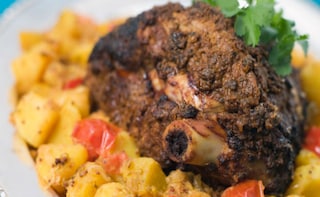Ramadan is not only that auspicious month in the Islamic calendar, but also a chance for people across different cultures to get a taste of some of the most mouth-watering and sought after festive dishes, cooked with utmost dexterity. One such example is the raan, which is popularly cooked during Iftar, and is a must try for all the meat lovers out there. Once considered a great finger licking experience for the great Mughal Kings, it goes way back to nomadic roots, developing in campfires and military kitchens in Central Asia as food for tribesmen and warriors.This lamb dish is cooked with the toughest cut of the lamb - the hind leg, which is usually used for keema. The secret to cooking raan lies in taking the toughest meat of the lamb and making it so tender and succulent "that you are able to eat it with a spoon". Yes, that's the challenge experts confidently swear on. A decade old trick is in taking half a seer of mutton (0.625 grams) and then cooking it in half a seer of chaach or buttermilk. This slow cooking in buttermilk is what breaks down the tough membranes and softens the meat.
Recipe by Chef Roopa GulatiThis rustic and hearty raan boasts of a shahi taste that will leave you wanting more.
Recipe by Aruna KirpalSlow cooked mutton leg served with roasted potatoes and fresh steamed vegetables. This zesty mutton dish is a must try for all meat lovers.
Recipe by Chef Niru GuptaLeg of lamb marinated in a variety of spices, cooked over slow heat and topped with an onion gravy. Click here for another version - Microwave Version.
Advertisement
Advertisement
Advertisement
Recipe by Chef Roopa Gulati
Advertisement
A slow-cooked raan dish that is guaranteed to impress
Recipe by Aruna KirpalSlow cooked mutton leg served with roasted potatoes and fresh steamed vegetables. This zesty mutton dish is a must try for all meat lovers.
Photo Credit: Istock
Recipe by Chef Niru GuptaLeg of lamb marinated in a variety of spices, cooked over slow heat and topped with an onion gravy. Click here for another version - Microwave Version.
For the latest food news, health tips and recipes, like us on Facebook or follow us on Twitter and YouTube.
Advertisement
